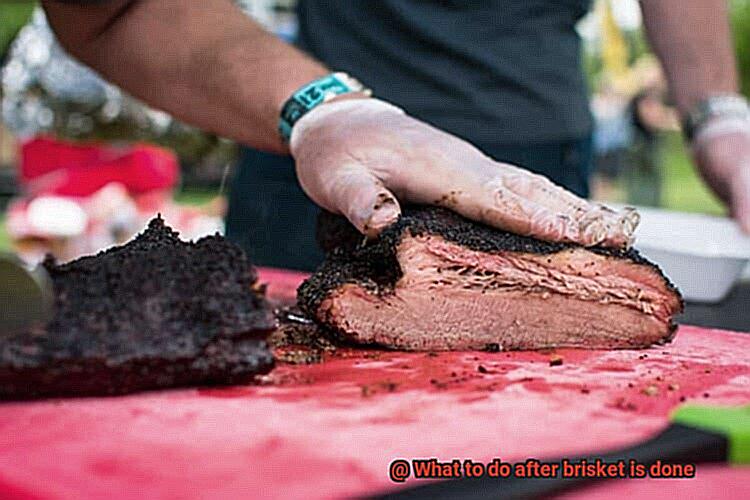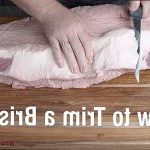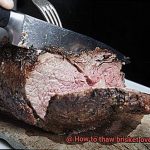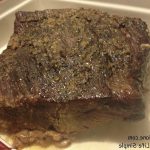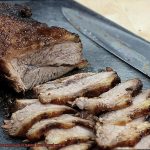The aroma is tantalizing, and your mouth waters in anticipation. But don’t get too excited just yet – the journey isn’t over.
As any seasoned pitmaster or cook will tell you, what you do after the brisket is done can make or break the final product. In this blog post, we’ll delve into everything you need to know about what to do after brisket is done.
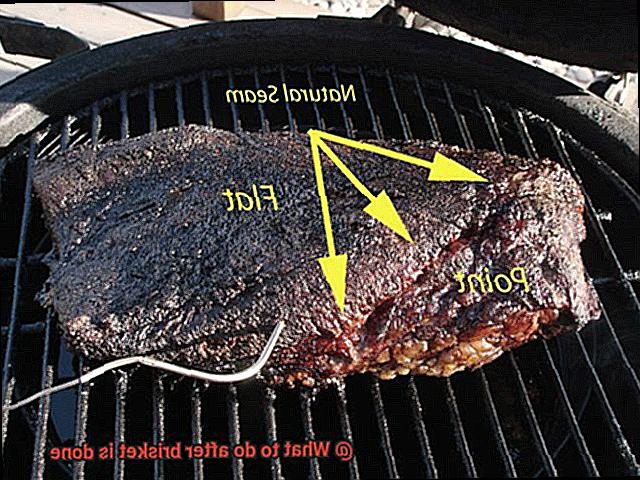
From allowing it to rest to carving it correctly, we’ll cover all the essential steps to ensure that your brisket is nothing short of perfection. We’ll even explore some creative ways to use those juicy leftovers and how best to store them for later.
Get ready to elevate your barbecue experience with these crucial steps that come after the brisket is done.
Contents
Step-by-Step Guide on How to Rest a Brisket
The hard part is over – you’ve smoked your brisket to perfection.
But before you dig in, there’s one crucial step left: resting. Resting is the key to unlocking the full potential of your brisket, allowing it to reabsorb its juices and become more tender and flavorful.
Lucky for you, resting a brisket is simple and straightforward. Let’s break it down step-by-step.
Step 1: Wrap it up.
Whether you choose foil or butcher paper, wrapping your brisket will help retain heat and moisture during the resting process. This means that your meat will continue cooking slowly while resting, allowing it to reabsorb all those delicious juices.
Step 2: Find a cozy spot for your wrapped brisket to rest.
A cooler or an oven set at a low temperature (around 150-170°F) works great for this. You want to create an insulated environment that will keep the meat warm for several hours.
Remember, patience is key – the general rule of thumb is to let the brisket rest for at least one hour, but some pitmasters suggest resting for up to four hours depending on the size of the cut.
Step 3: After patiently waiting for your brisket to rest, it’s time to uncover and admire your handiwork.
You may notice some liquid in the foil or paper – this is a good sign that the meat has reabsorbed its juices and is ready to be sliced. But wait.
Don’t start cutting just yet.
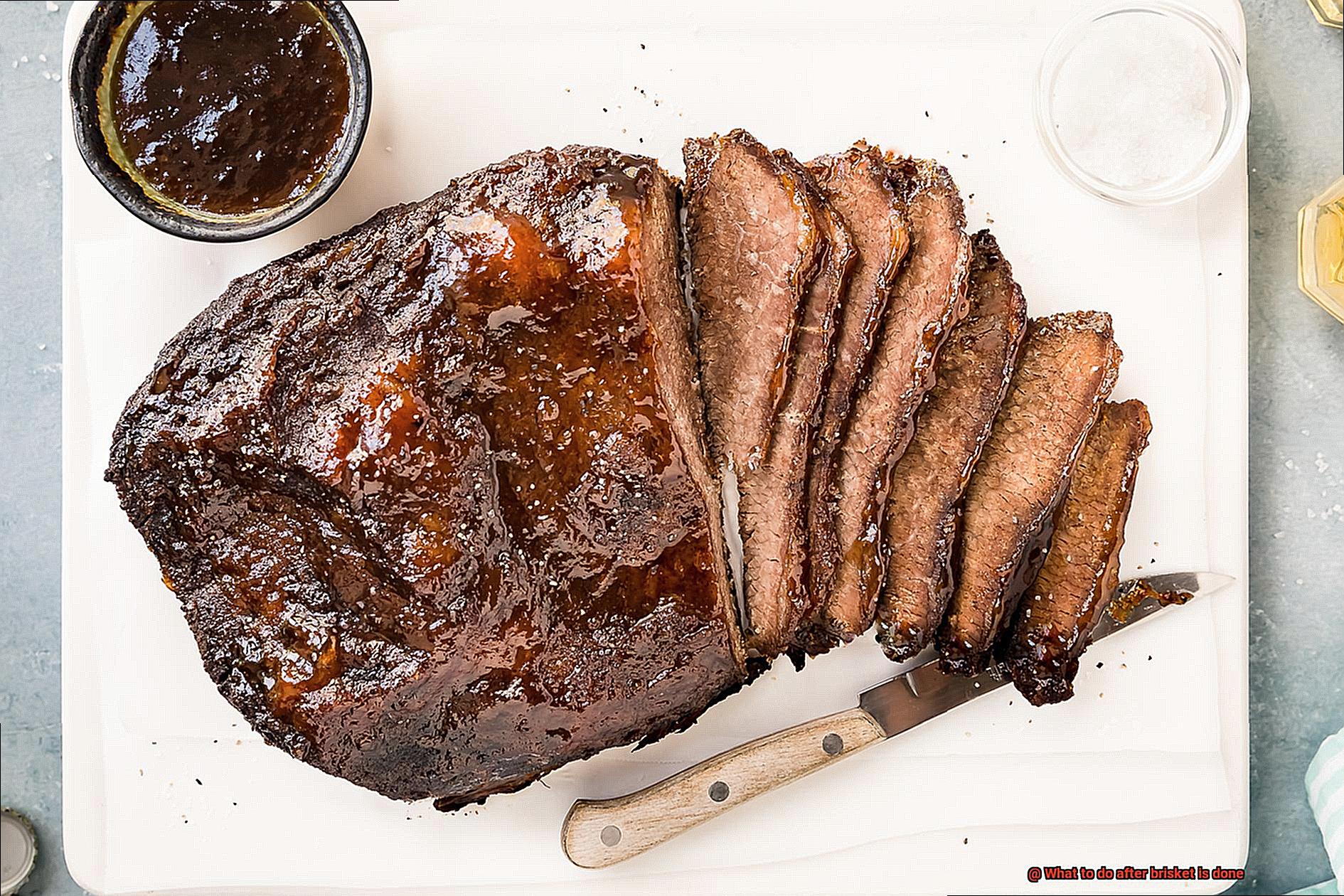
Step 4: Let the brisket sit for another 10-15 minutes before slicing.
This allows the juices to redistribute evenly throughout the meat, preventing them from escaping when cutting into the brisket. Trust us, this extra step is worth it for a perfectly juicy and tender brisket.
And that’s it – just four simple steps to perfectly rested brisket. But what about leftovers?
No worries – just make sure to let the brisket cool down to room temperature before storing it in the fridge. Wrap it tightly in foil or plastic wrap before placing it in the fridge, where it can be stored for up to four days before reheating.
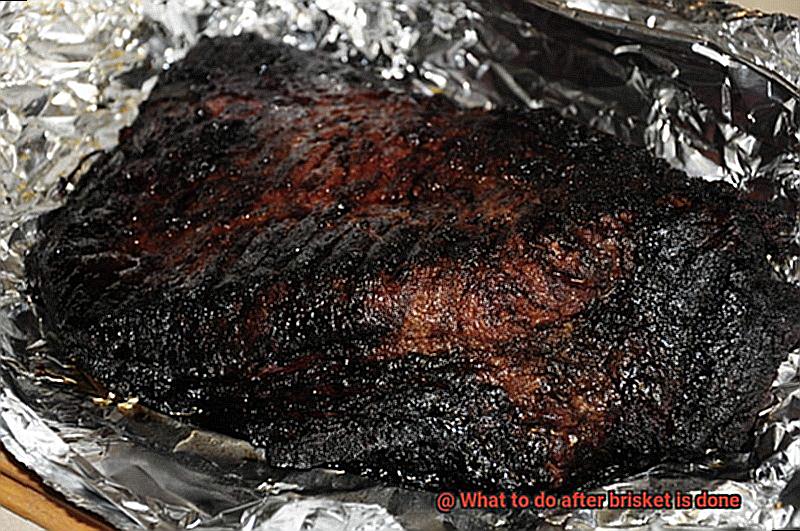
Tips for Keeping the Brisket Warm While Resting
Then, you know the importance of resting it before serving. Resting allows the juices to redistribute throughout the meat, making it more tender and flavorful. However, keeping the brisket warm during this process is crucial to avoid cold spots and ensure that it stays at a safe temperature. Here are some tips for keeping your brisket warm while resting:
Wrap it in Foil and Towels
Wrapping the brisket in foil will help retain heat, while wrapping it in towels or a blanket will provide an extra layer of insulation, keeping the brisket warm for several hours. The combination of foil and towels will keep the heat in and prevent any cold spots from forming.
Use a Cooler
A cooler is an excellent tool for keeping your brisket warm for several hours. Preheat the cooler by filling it with hot water for 20-30 minutes before placing the wrapped brisket inside. The insulation of the cooler will keep the brisket warm, allowing it to rest peacefully until you’re ready to serve.
Utilize a Warming Drawer
If you have a warming drawer in your oven or smoker, set the temperature to around 150-160 degrees Fahrenheit and place the wrapped brisket inside. The warming drawer will maintain a consistent temperature, perfect for keeping your meat warm while redistributing its juices.
Keep It on the Smoker
If your smoker can maintain a low temperature, another option is to leave the wrapped brisket on it until you’re ready to serve. This method allows you to keep an eye on the temperature of your meat while maintaining its smoky flavor.
Remember that it’s essential to keep an eye on the temperature of your brisket and ensure that it stays above 140 degrees Fahrenheit to prevent any food safety issues. Resting a brisket takes patience, but trust us; it’s worth it when you take that first bite of juicy, flavorful meat.
How Long Should Brisket be Allowed to Rest?
It’s a true delicacy that requires some skill to cook, and one crucial step in the process is allowing it to rest after smoking. But the question on everyone’s mind is, how long should you let it rest?
In general, you should let your brisket rest for at least an hour before cutting into it. This will allow the juices to redistribute throughout the meat and make it tender and flavorful.
However, keep in mind that the size of your cut plays a significant role in determining the resting time. A larger brisket may require up to three hours of patient waiting before you can slice into that succulent meat.
Now, onto the real challenge: keeping your brisket warm while it rests. One popular method is to wrap your prized meat in foil and place it in a cooler.
But don’t forget to preheat the cooler with hot water first. This will help maintain the temperature of the meat and prevent it from cooling down too quickly.
But here’s a word of caution – don’t leave your brisket in the cooler for too long. Two to three hours is the maximum time it should stay in there; any longer can cause it to become overcooked and dry.
And nobody wants that. Once your brisket has rested sufficiently, you can keep it warm by wrapping it in foil and placing it in an oven set at a low temperature (around 150-175°F).
What to do Before Putting the Brisket in the Fridge
Resting a brisket after smoking is essential for achieving a tender and juicy final product. It’s equally important to prepare the brisket correctly before storing it in the fridge to ensure maximum flavor retention.
Here, we’ll explore some steps to take before putting the brisket in the fridge.
Resting the Brisket: The Key to Tender and Juicy Meat
After smoking the brisket, give it time to rest before storing it in the fridge. Resting allows the juices to redistribute throughout the meat, resulting in a moist and flavorful brisket. Wrap the brisket in foil or butcher paper and let it rest for at least an hour. The size of the brisket determines the resting time, but don’t rest it for too long as it can overcook and become dry.
Cooling Down the Brisket: Gradual Temperature Reduction
Before putting the brisket in the fridge, let it cool down to room temperature for about 30 minutes. A gradual temperature reduction prevents any potential bacterial growth due to temperature fluctuations. Never put a hot brisket directly into the fridge as condensation can form, leading to bacteria growth and spoilage. Letting it cool down naturally before wrapping it up and placing it in the fridge helps avoid this.
Wrapping the Brisket: Keeping Moisture In
When storing the brisket in the fridge, wrap it tightly in foil or plastic wrap to prevent air from getting in and drying out the meat. Wrapping also keeps moisture inside, which prevents the brisket from becoming dry and tough. Label the brisket with the date and store it on a tray or plate to catch any liquids that may leak out of the foil or plastic wrap.
Cutting the Brisket: Patience is Key
Letting meat rest before cutting ensures that juices are evenly distributed throughout the meat. After taking it out of the cooler or oven, let it rest for at least 20-30 minutes before cutting into it. Use a sharp knife and slice against the grain for maximum tenderness.
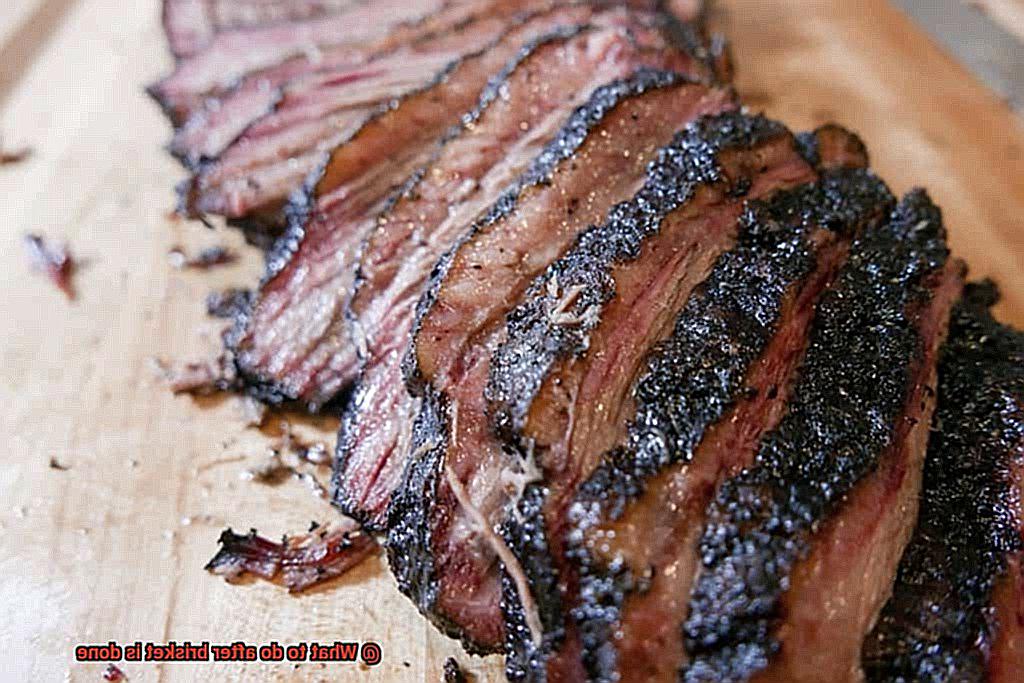
Reheating the Brisket: Slow and Low
When reheating brisket, do it slowly and at a low temperature to prevent overcooking and drying out. Place the wrapped brisket in an oven set at 250°F until heated through, or use a slow cooker set on low for several hours. Adding a bit of broth or water can help keep the meat moist during reheating.
In conclusion, properly resting and storing a brisket after smoking is crucial for achieving a delicious final product. By following these simple steps, you can ensure that your brisket stays tender and juicy even after being stored in the fridge.
Reheating a Previously Refrigerated Brisket
Firstly, let your brisket come to room temperature before reheating. Give it about an hour to adjust to room temperature and avoid shocking it with heat.
Next, preheat your oven to 250°F. This low and slow method is the key to ensuring that your brisket is heated through evenly without losing any of its juicy goodness.
Place the brisket in a baking dish or on a sheet pan, cover it with foil, and add a small amount of liquid such as beef broth or water to keep it moist during reheating. Now, place the dish in the oven and let it work its magic for 1-2 hours depending on the size of your brisket.
Use a meat thermometer to ensure that the internal temperature has reached at least 165°F for safe consumption. Once your brisket is heated through, remove the foil and let it rest for 10-15 minutes before slicing and serving.
This will help retain moisture and make it easier to slice. Alternatively, if you have more time on your hands, you could also reheat your brisket in a slow cooker or on a smoker at a low temperature for several hours.
Remember, reheating a brisket is not something that can be rushed. Take your time and be patient – your taste buds will thank you for it.
Patience is Key: Letting the Meat Rest Before Cutting
Think of your brisket as a sponge. While cooking, all those delectable juices are being squeezed out and absorbed into the muscle fibers.
But if you don’t let it rest before cutting into it, all those juices will flood out onto your cutting board, leaving you with a dry and tasteless piece of meat. That’s where the magic of resting comes in.
Resting your brisket for at least an hour (or two if you can wait) allows the juices to redistribute evenly throughout the meat. This means that every bite will be bursting with flavor and moisture, not just the first few slices.
But how do you rest your brisket without it getting cold or overcooked? The answer is the “Texas crutch.”
Wrap your brisket tightly in foil or butcher paper and place it in a cooler to keep it warm. This method will keep the temperature constant while allowing the juices to settle back into the meat.
Now, I know waiting can be tough when you’re famished and staring at a mouth-watering piece of meat. But trust me, the final result is worth every moment of waiting.
Besides, while your brisket rests, you can prepare some delicious sides or grab a cold drink to accompany your meal. When it’s time to cut into your brisket, remember to slice against the grain for maximum tenderness.
And if there are any leftovers, store them in the fridge within two hours of slicing while keeping them intact to preserve their moisture. In conclusion, don’t rush your brisket.
Allowing it to rest for at least an hour (or two) is essential for achieving juicy and flavorful meat.
8Er9Hdnd50Q” >
Conclusion
In conclusion, the journey of cooking a brisket doesn’t end when it’s taken out of the smoker or oven.
The real magic happens after the brisket is done, and what you do next can make or break the final product. Resting is crucial to unlocking its full potential – allowing it to reabsorb its juices and become more tender and flavorful.
But don’t rush this process. The general rule of thumb is to let the brisket rest for at least an hour, but some pitmasters suggest resting for up to four hours depending on the size of the cut.
Once your brisket has had time to rest, it’s time to uncover and admire your handiwork before slicing.
But before you store it in the fridge, make sure you’re taking all necessary steps to ensure maximum flavor retention. Cooling down gradually, wrapping tightly in foil or plastic wrap, labeling with date, and storing on a tray are all essential steps that will make a big difference when reheating later.
Speaking of reheating – if you’re lucky enough to have leftovers, there are a few things to keep in mind.
First off, let your brisket come to room temperature before reheating slowly at a low temperature with added liquid like beef broth or water. This will help retain moisture and prevent dryness – something no one wants in their barbecue experience.
This allows juices to redistribute evenly throughout the meat resulting in a moist and flavorful brisket that will impress even the most discerning barbecue connoisseurs.

